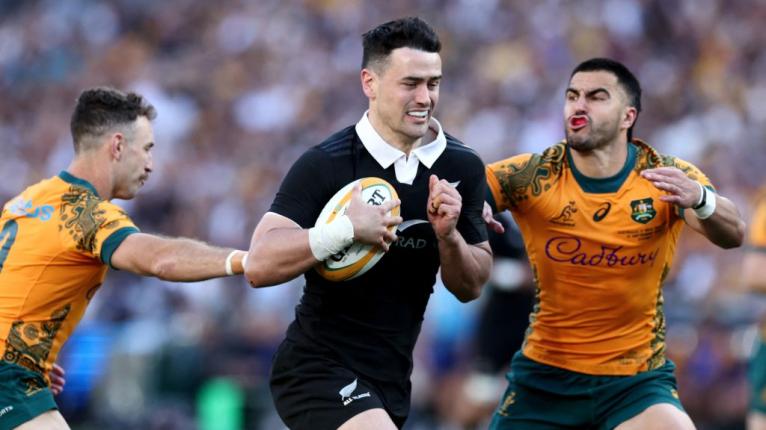Back in 1950s America, carnival booths often gave out cigars as prizes. If you did not win when you had the chance, you were unwittingly adding to a new sporting mantra and helping to birth a famous saying: ‘close, but no cigar’. It is a maxim Joe Schmidt’s Wallabies will be contemplating with deep reverence, and more than a hint of frustration over the next few days.
It is not the first time the cup has been dashed from green-and-gold lips in the very act of quenching Australia’s thirst for rugby success. Who will ever forget the finish of the game between the All Blacks and Dave Rennie’s Wallabies two years ago at the Docklands Stadium in Melbourne? Australia were leading 37-34 with less than a minute remaining.
Referee Mathieu Raynal awarded the Wallabies a penalty less than five metres from their goalline. All Bernard Foley needed to do was kick the ball to touch, and that would seal a famous victory. Simple enough, surely?
In the event, Foley delayed the kick fatally despite repeated prompts – six renditions of ‘we play!’ – from M. Raynal. The official lost patience and awarded the All Blacks a scrum. Every Wallaby supporter still shakes his or her head ruefully at what happened next. Jordie Barrett, inevitably, touched down in the right corner to snatch victory for the men in black on the next sequence of play.
That game was part of an all-too-familiar pattern in recent seasons. Nine days later at Eden Park, Australia were shattered 40-14 Eden Park. In the inaugural game of the Rennie era in 2020, the Wallabies drew 16-16 in Wellington only to lose by 20 at the ancestral home of the All Blacks in Auckland one week later.
You do not get a second shot at beating the All Blacks, especially if you refuse to take a game that is yours to win by the scruff of its neck. Wind the clock on to 2023: Eddie Jones’ charges were demolished 38-7 in Melbourne, but looked to be on course to gain revenge in the return match at Dunedin. They led 17-3 at the half only to be overhauled by a penalty goal in the final minute and lose 23-20. The referee was the same man who policed the 2024 game last weekend in Sydney, Englishman Karl Dickson.
With nine minutes to go at the Accor Stadium the All Blacks were 10 points ahead on the scoreboard, but two men short on yellow cards. We know New Zealand cannot score in the final quarter – their points tally in the last 20 minutes in this Rugby Championship now stands at an astonishing zero and their overall points margin at minus 50 – so the game was at the mercy of Schmidt’s charges. Although Australia scored one more seven-pointer for a final 31-28 scoreline, it was the same old heartbreaking story again – another case of ‘close, but no cigar’.

With the benefit of hindsight, frustration will be mixed with relief for the Wallaby coaches. The New Zealanders were 21-0 up after 17 minutes, and 28-7 after 26 minutes. The Kiwis were rattling along at a point per minute and it looked like matters could turn out just as badly for Australia as they had in Santa Fe, when Argentina hammered them 67-27.
There was little sign of improvement in an Australian defence which regularly gave up the second pass without any pressure on the ball, as examined in my previous piece.
Schmidt’s scrum coach Mike Cron had already reached maximum pressure well before a brief expletive-ridden half-time boil-over on Stan Sport:
“We’ve just got to get bloody harder on defence and a bit quicker into position and come on up.
“We’re just letting them have far too much bloody room for their skill level.
“We’ve just got to get up and get in their face a hell of a lot better in the second half.”
The head coach had a different view from the all-seeing eyrie than his assistants, and the time-honoured mechanism to protect a shaky defence for a Schmidt-mentored team is to control the ball better when in possession. From the man himself: “I just felt we gave up too many line breaks. We were too loose with the ball and they are so dangerous in turnover balls, so we just had to make sure we were looking after the ball.”
The ruck-building stats illustrate the change of momentum revealingly.

As the All Blacks dwindled, so the Wallabies burgeoned in the high stakes game of ball retention. If you can keep the ball for 70 rucks in one half of footy, you will not be doing much defending at all, and that kept the worst of the pressure off Laurie Fisher’s ailing defence.
That is one classic ingredient in Schmidt’s secret winning sauce. His other super-strength is the accurate identification of weaknesses in the opposition defence from set-piece, and the imaginative creation of plays to exploit them. The first opportunity arose in 18th minute.

Throughout the game the All Blacks adopted a risky policy of ‘jacking’ two jumpers up into the air on the Wallaby lineout throw. They won four turnovers from it but the little victories were bought dearly. In this instance both Scott Barrett and Wallace Sititi are airborne and the defensive tail-gunner [hooker Codie Taylor] is glued to Sititi’s backside.
It means six New Zealand forwards are fully occupied with jumping and lifting, and only two [Ethan de Groot at the front and Sam Cane in midfield] with defending. Neither are in any position to influence the play as Fraser McReight strolls through a hole around the end of the lineout so yawning any one of four Australian players could have scored the try. It looked for all the world like a training run.
Schmidt summarized the attacking intent from lineout after the game:
“Our lineout probably came under a bit of pressure because we got a few field positions that we were hopeful to make a bit of a difference with, and we didn’t quite do that.
“One of the things with the All Blacks is you’ve got to nail opportunities that you do get. First time we got down here, we put a nice set play together to get the seven, to get a little bit of confidence. And in the second half, we put a few things together.”
The Wallabies found a mountainous pot of gold at the end of the lineout rainbow in the second period.
In this example, Sititi does not compete at the end of the line and Taylor remains connected to the defence, but there is still a definite opportunity if Marika Koroibete catches the ball; or even better, if the pass from Bobby Valetini goes straight through the ‘tunnel’ to Noah Lolesio instead.
Schmidt’s men kept hammering away at the same weakness with a variety of weapons.

Keep your eyes on the two men who have responsibility for guarding that space around the end of the line – number five Tupou Vaa’i and Codie Taylor’s replacement, 16 Asafo Aumua. Both are involved on first phase, with Vaa’i taking out wing Dylan Pietsch without the ball and Lolesio spinning away from the challenge of Aumua. The Wallabies then go back to exactly the same hole with a repeat play on the following phase. Vaa’i’s head is spinning and he is still trying to recover from the hit, while Aumua fails to spot the danger area until it is too late.
With two All Blacks off the field in the last 10 minutes, Schmidt’s charges were able to develop their play further from the same base.
Once again, an accurate throw from Brandon Paenga-Amosa over the end of the line finds the Kiwi defence in dire straits in that space. Aumua cannot handle the power of Langi Gleeson [in the red hat] in the tackle in the first instance, and if you swap around Tom Wright and Harry Wilson on the final play, the Wallabies are probably in for another try down the right-hand side.
These were all encouraging signs of progress, cast from a typical Schmidt mould, in a new era for Australian rugby. As the Wallaby supremo added: “I think belief takes a while to build. And I just felt we gained a bit of confidence – as long as we can keep building on that confidence, because I thought we were a little bit static in the first half.”
His Wallabies are beginning to look the goods when they can control the ball at the breakdown and launch their plays off set-piece. Defence remains a thorny problem: unlike Shaun Edwards and Andy Farrell, Laurie Fisher is primarily a breakdown specialist who coaches line speed and line spacing as add-ons. League coaches handle it the other way around. In the long term, Schmidt will probably need a dedicated expert in that critical area to work alongside ‘the Lord’.
The other pressing issue is the need to back up one good performance with another against the same opponents. Recent Bledisloe Cup history is full of close shaves one week, and an All Blacks’ blowout the next.
As ex-Wallaby centre turned Stan Sport pundit Morgan Turinui warned, “He’s got to be happy with his second half, Schmidt. [But] let’s not forget, [it was] 28-7 at one stage in that first half. [The score] could have been anything. Over 68,000 fans, lots of gold. It feels like an early-2000s Bledisloe [cup game now], but it didn’t look that way early on.”
Boston Celtics’ Basketball coach ‘Red’ Auerbach was famous for his habit of puffing away on a victory cigar well before the game had run its course. He was that confident, on the back of eight championship wins in a row in the 1960s. It is high time for the Wallabies to sit back, relax and light up one of their own.


Joe Schmidt. Mr 44%andFalling
So much for Schmidt building cohesion in the squad for Saturday .....
We have seen this before from kiwi coaches in Australia.
It's either deliberate or incompetence.
Exactly as I predicted. Slowly but surely slipping more Tahs back in to the team, despite being the most useless Australian franchise.
7 Tahs in the 23 this week. I am loving it. On tour, we could add Latu and Skelton from La Rochelle via Sydney and maybe give Swinton a run. Get it up to 10. Oh, nearly forgot Jed and Ned. The world would be a far better place.